
Cleaner air in cities
Air pollution is a societal challenge, causing 4.2 mio. premature deaths worldwide and approximately 500.000 in Europe each year (data from 2016). All in all, air pollution is estimated to cost the society of the WHO European Region US$ 1.6 trillion. There are therefore good reasons – both economical and health related – both in urban and rural areas, to reduce air pollution.
Danish Technical Institute is a central partner for actors stakeholders within clean air. We assist municipalities and authorities who request documentation, advice, and specific air quality measurements in urban environments, but also technology suppliers who request independent documentation of how well their clean air technologies work.
Many options to reduce the level of air pollution
The local municipalities have a range of options to work actively towards reducing the air pollution. Examples include:
- Reduce the traffic through car-free roads
- Improve the public transport or change it to run on hydrogen or electricity
- Tighten regulation of industrial emissions
- Adjust intersections to improve traffic flow
Many municipalities – not least in the larger cities – are aware that air pollution has large both health-related and economic consequences. In the dialogue with the municipalities, we at Danish Technological Institute experience that it is difficult for the individual municipality to get an overview of where the air pollution is coming from, where the problems are largest and what are the most economically efficient initiatives towards cleaner air.
Preliminary dialogue creates overview
Often, harmful particles and gases can neither be seen, smelled or tasted, and there can be many sources in a municipality with agriculture, industry, production and various forms of traffic. At Danish Technological Institute we constantly keep updated with regards to new technologies and specific initiatives in many countries as well as collaborate with municipalities at various levels in specific projects about air pollution. In the preliminary dialogue we are therefore using both our own and other’s experiences. This can contribute to create a preliminary overview over the most effective measures.
Local measurements document the level of air pollution
But all municipalities are different. To get a well-documented basis for decisions in the municipality it can be relevant to use specific measurements in the municipality to gain an insight into which sources or measures that should be prioritized.
The Danish Technological Institute uses an approach based on actual measurements of the air pollution. This gives a high degree of certainty that the results are representative for the local situation. We can among others help with:
- Measure and analyze the air pollution in bounded areas for instance streets or neighborhoods with many wood stoves, heavy traffic, or industry – and also assess if limit values are complied with
- Develop a plan for measurements of air pollution in an entire city
- Assess the emissions from singular sources such as agriculture, wastewater treatment plants, incinerators etc.
- Rank the air pollution sources to allow the municipality to prioritize initiatives
- Evaluate the environmental and socioeconomic effect of already implemented initiatives. This can form the basis for best practice guidelines.
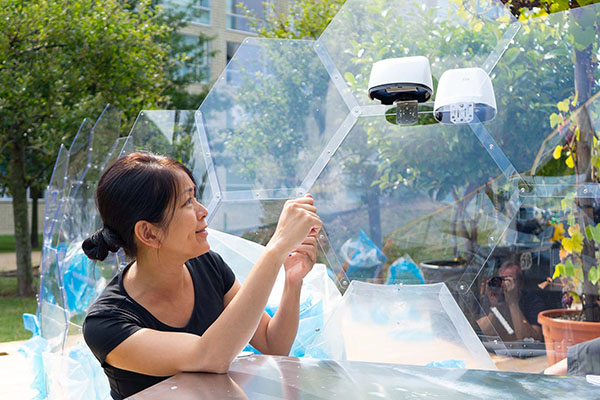
Lowcost sensors are being installed to measure air quality in the Thrivezone Amager project in Copenhagen.
The sensor market invites for citizen science
In recent years a new generation of air quality sensors has come to market. Characteristic for these sensors is that they are significantly cheaper than traditional instruments, and that they are easy to use. With the new generation of cheap sensors, new possibilities arise for involving the citizens in the measurement of air pollution in selected areas. This can create visibility for an issue which is otherwise invisible in the everyday life. The citizen can be involved in various ways:
- The citizens point out/prioritize measurements for locations with perceived poor air quality
- Measurements of air quality on schools and using the measurements as part of the teaching
- Pupils who measure the air quality on their way to/from school and reduce their exposure through the selection of routes with better air quality.
- Measurements in areas with particularly vulnerable persons (e.g. schools, kindergartens, hospitals, nursing homes for elderly people etc.)
At Danish Technological Institute we are happy to contribute to a discussion of when and where the municipality specifically can benefit from involving the citizens.
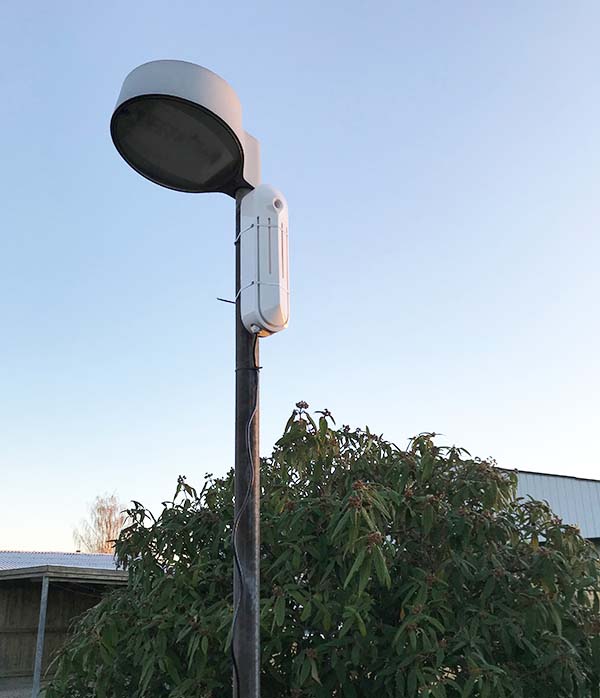
In a suburb outside of Aarhus, we are measuring emissions from wood-stoves using low-cost sensors.
Important to choose the right sensors
Danish Technological Institute has a large experience evaluating, selecting, and applying low-cost sensors. We can therefore advice the municipalities about the most optimal solution for the specific situation – among others:
- Advice on what sensors can measure and their applicability in various measurement scenarios
- Instruct in the application of sensors for measurements of air pollution
- Calibrate low-cost sensors against reference equipment in the laboratory and in the field
- Advice on involvement of citizens in the measurements of air pollution including:
- Possibilities and limitations of the sensors
- Analysis of the collected data
- Motivation and retention of citizens involvement in air quality measurements
- Implementation of initiatives based on the citizens’ measurements of air quality
Green infrastructure – advantages and pitfalls
Vegetation in urban environments (green infrastructure) such as hedges, trees, green roofs etc. have a range of advantages: Increased biodiversity, reduced heating of the city (reduced urban heat island effect), reduced air pollution and improved mental health for the citizens. Many cities therefore choose to use green infrastructure as a solution to multiple environmental problems in the cities.
However, there are many different initiatives and solutions when it comes to green infrastructure and there can be a huge difference in the effect of the various initiatives.
Danish Technological Institute has the equipment and skills to advice on the use of green infrastructure towards reducing air pollution and for analyzing the effect of this after implementation. This means that we can help the municipality with choosing green infrastructure initiatives that deliver the necessary effect.
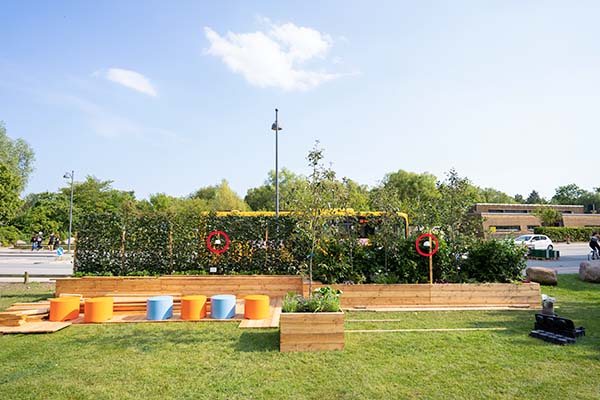
Here, we are measuring the effect of a nature-based solution (NBS) in Copehagen using lowcost sensors.
Projects
We collaborate with municipalities, cities, companies and knowledge institutions to develop, mature and validate the clean air technology of the future. See examples here.
 Reduction of emissions from wood-burning stoves
Reduction of emissions from wood-burning stoves
In Denmark, it is estimated that wood stoves and boilers account for 65-70% of the emissions of particulate matter and black carbon from Danish sources. How do we minimize emissions? And which measures are most effective? With a sensor network in a wood-burning stove neighborhood in Aarhus, we measure the effect of a wide range of measures that limit emissions from wood-burning stoves. This provides authorities, municipalities, companies and other stakeholders with a data-based decision-making basis for future investments in clean air measures.
Partners: DAPO, Aduro, HWAM, Morsø Jernstøberi A/S, HETA, Schiedel Skorstene, Exodraft, Blue Chimney, Leapcraft, Katzenmark, SBI, DCE- National Center for Environment and Energy, Aarhus Municipality, Danish Technological Institute (project manager)
Project type: Full-scale project supported by MUDP under the The Danish Ministry of Environment
Read more about the project here.
 The Green Construction Site of Tomorrow
The Green Construction Site of Tomorrow
2030 climate goals and a strong focus on pollution from urban construction sites make it necessary to look at green transition in the construction industry. Until December 2023, the project The Green Construction Site of Tomorrow will investigate the effect of various measures on a selected construction site where Per Aarsleff is the contractor. The project will establish a data-driven full-scale demonstration of the green construction site of tomorrow.
Partnere: Per Aarsleff A/S, Airlabs Denmark, Alumichem A/S, Purefi A/S, CP ApS, DTU - Engineering, DCE - National Center for Environment and Energy, Aarhus University, Aarhus University - Engineering, Volvo Construction Machinery, Danish Technological Institute (project manager)
Project type: Full-scale project supported by MUDP under the The Danish Ministry of Environment
Read more about the project here.
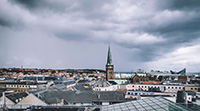 DivAirCity - improving air quality in five European cities
DivAirCity - improving air quality in five European cities
Aarhus is among the pilot cities in a 4-year EU project that will test green initiatives to improve air quality in five European cities. This will be done with a special focus on diversity and diversity - and on making the city a better place to live for all parts of the population. With a high degree of citizen involvement, the project will design and implement clean air measures that take into account a number of citizen groups that may be particularly vulnerable to air pollution.
Partners (Aarhus): Danish Technological Institute, DCE - Danish Centre for Environment and Energy, Aarhus Municipality - and a large number of partners in the cities of Bucharest (Romania), Castellón (Spain), Orvieto (Italy) and Potsdam (Germany).
Project type: EU research and innovation program Horizon2020
Read more about the project here.
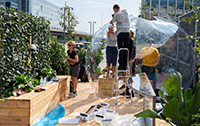 ThriveZoneAmager
ThriveZoneAmager
Through air measurements, citizen involvement and the temporary establishment of three urban spaces, the project investigates whether it is possible to design inviting urban spaces that can simultaneously shield against air pollution. As part of the project, three temporary urban spaces were established on Amager in mid-August 2021, where the Danish Technological Institute has been responsible for documenting the effect of the various measures.
Partners: Gehl, Urban Digital, Backscatter, Studio Profondo and Danish Technological Institute
Project type: Project is supported by ICLEI Action Fund
Read more about the project here (in Danish).
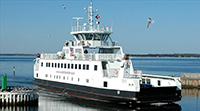 Maritime Emission Solutions in Coastal Waters
Maritime Emission Solutions in Coastal Waters
There is a strong focus on the environmental and health effects that emissions from ships contribute to coastal areas and in Danish harbor cities. In the project, two different emission control solutions are tested on board two different Danish vessels sailing in coastal waters. The goal is to reduce particle pollution by 98 percent on both vessels and NOx emissions by 80 percent on a vessel that is also equipped with a NOx catalyst. A significant reduction in low-frequency noise is also achieved.
Partnere: Exilator ApS, Purefi A/S, Hundested-Rørvig Færgefart A/S, World Marine Offshore, Aarhus University, Danmarks Rederiforening, Danske Maritime and Danish Technological Institute (project manager)
Project type: Full-scale project supported by MUDP under the The Danish Ministry of Environment
Read more about the project here (in Danish).
